 |
UZBEKISTAN
12 Jul Samarkand |
 |
UZBEKISTAN
12 Jul Samarkand |
Along the way, we passed through vegetable farms, wheat fields, ugly
industrial towns, wild desert wastelands, as well as a mini-sandstorm and
a brief shower. Finally reached Samarkand early in the morning.
"In all the other parts of the world light descends upon earth. From holy Samarkand and Bukhara, it ascends."
Local proverb.
"For lust of knowing what should not be known,
We take the golden road to Samarkand."
James Elroy Flecker, Hassan, 1913.
Well, we reached Samarkand without any Uzbek soms on hand, and a taxi driver offered to change with us for 175 Soms = US$1 (This is the black market rate; Official rate is 90 soms = US$1). Although we had agreed on US$1 for the ride to Hotel Samarkand from the bus station, this chap later demanded US$3…
At Hotel Samarkand, we borrowed the hotel phone (for free) to ring Kutbiya Rafiewa (Address: Iskandarow Str., 38, 703012 Samarkand, Tel: [3662] 352092, 353823, 354527) who runs a homestay at her home near Guri Amir (Tamerlane, or more politically correct, Timur's Mausoleum). Yes, she had vacancies and her sister, Aziza, brought us to the place - a traditional house with a vine-sheltered courtyard (US$8 per person, plus US$3 for an enormous dinner). We were to spend the next few nights in a shed in the garden. Here we were surrounded by apple trees, mulberry trees, pomegranate trees, etc, as well as an inquisitive cat and some chickens. Best of all was this very friendly family who was always providing us with lots of tea and snacks, as well as a lively exchange of views and ideas. We have learned so much about this beautiful country and her people as well as their aspirations, after a few late night conversations with Aziza and a few of her other English-speaking relatives.
A special note must be made for a bed-like platform called the takhta
in Uzbek or chorpoy in Tajik. Uzbek and Tajik family and social life
evolve round this platform. The takhta (or chorpoy) is usually covered
with carpets and sometimes has a little table on it. Families eat
on it and remain there after meals chatting, when having no other tasks
round the house. Many restaurants and choyhonas (teahouses) also have
such platforms where men sit around chatting about life and current affairs.
Soviet rule did nothing to change this age-old custom. Such platforms
are found even below modern apartment blocks.
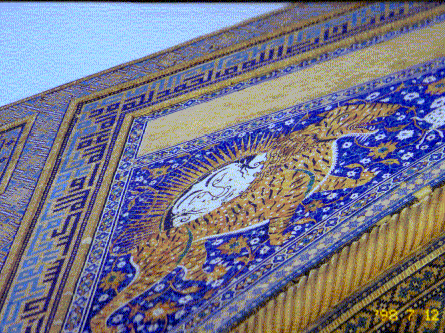 |
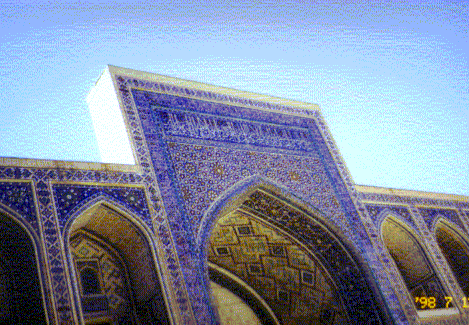 |
 |
| More tigers | Ulughbek Medressa | Sher Dor (Tiger) Medressa |
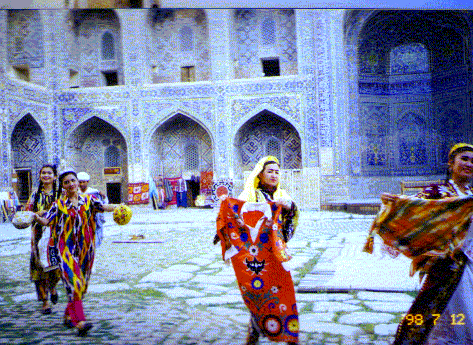 |
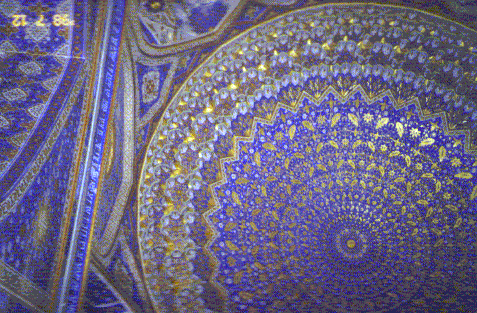 |
|
| Inside the Medressas: Light | "Wedding Ceremony" - a play | Inside glories |
G.N. Curzon, Russia in Central Asia, 1889
After settling down and a quick bath, we visited the renowned Registan
(As grand as it sounds, it was built by Timur with the craftsmen of the
Eurasian lands he conquered. Definitely the most beautiful monument
in Uzbekistan.) and the Bazaar (Very Middle Eastern in atmosphere but nothing
in scale when compared with those in Istanbul and Cairo.). We also
passed the Bibi Khanum, Timur's grand mosque (to be built without grandeur
anywhere), shrouded with the restorers' scaffolding and cranes. Apparently,
it has been in restoration for the past decade or so, as an Italian I met
later told me. He had been here in the 1980's when this was still
the Uzbek Soviet Socialist Republic. In the evening, we watched the
"Wedding Ceremony", a cultural drama performance, at the Registan Square
(US$7). Despite Samarkand's legendary reputation, there were few
tourists. Indeed there were only four tourists watching 20 plus performers.
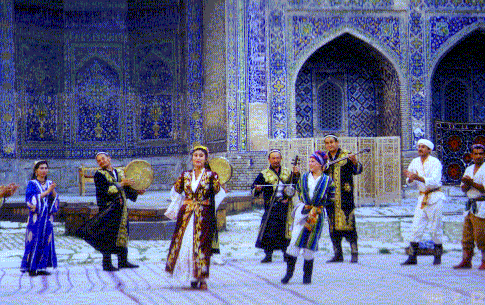 |
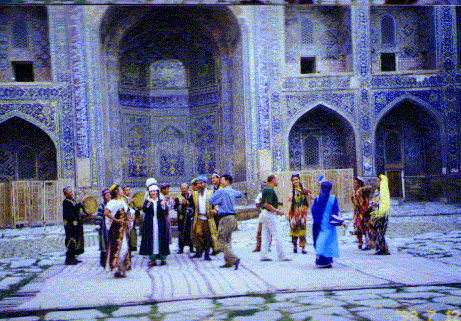 |
|
| Uzbek-Tajik musicians | "Wedding Ceremony" - a play | Join the fun ! |
|
|
Click here to send an email to Tan Wee Cheng |